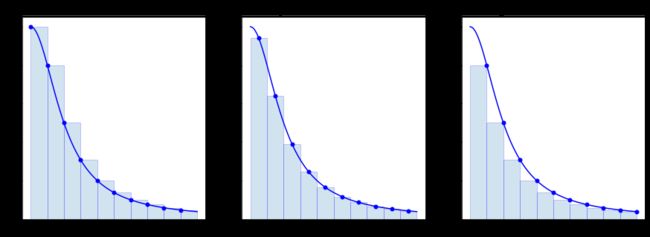黎曼求和
这里有一块形状不规则的土地,要测量它的面积,怎么办呢?一个叫黎曼的德国数学家(Bernhard Riemann, 1826-1866),他想了个办法:将这不规则图形切成一条条的小长条儿,然后将这个长条近似的看成一个矩形,再分别测量出这些小矩形的长度,再计算出它们的面积,把所有矩型面积加起来就是这块不规则地的面积。这就是著名的“黎曼和”。小长条宽度趋于0时,即为面积微分,各个面积求和取极限即为定积分。虽然牛顿时代就给出了定积分的定义,但是定积分的现代数学定义却是用黎曼和的极限给出。
定义
对一个在闭区间有定义的实值函数,关于取样分割、的黎曼和定义为以下和式:
和式中的每一项是子区间长度与在处的函数值的乘积。直观地说,就是以标记点到X轴的距离为高,以分割的子区间为长的矩形的面积。
函数 在分区上:
求和:
每个值在 中每个子间隔中是任意的。
黎曼和很重要,因为提供了一种简便的方法来逼近定积分:
请注意,每个i的乘积是高度为且宽度为的矩形的面积。
我们可以将黎曼和视为N个矩形的面积,其高度由来确定。
在每个子间隔中选择的是任意的,但是有一些明显的选择:
- 左黎曼和是指每个是子区间的左端点
- 右黎曼和是指每个是子区间的右端点
- 中点黎曼和是每个是子区间的中点
通过以下举例函数,用Python可视化左、右、中黎曼和:
在间隔上,分区大小为。
import numpy as np
import matplotlib.pyplot as plt
%matplotlib inline
f = lambda x : 1/(1+x**2)
a = 0; b = 5; N = 10
n = 10 # Use n*N+1 points to plot the function smoothly
x = np.linspace(a,b,N+1)
y = f(x)
X = np.linspace(a,b,n*N+1)
Y = f(X)
plt.figure(figsize=(15,5))
plt.subplot(1,3,1)
plt.plot(X,Y,'b')
x_left = x[:-1] # Left endpoints
y_left = y[:-1]
plt.plot(x_left,y_left,'b.',markersize=10)
plt.bar(x_left,y_left,width=(b-a)/N,alpha=0.2,align='edge',edgecolor='b')
plt.title('Left Riemann Sum, N = {}'.format(N))
plt.subplot(1,3,2)
plt.plot(X,Y,'b')
x_mid = (x[:-1] + x[1:])/2 # Midpoints
y_mid = f(x_mid)
plt.plot(x_mid,y_mid,'b.',markersize=10)
plt.bar(x_mid,y_mid,width=(b-a)/N,alpha=0.2,edgecolor='b')
plt.title('Midpoint Riemann Sum, N = {}'.format(N))
plt.subplot(1,3,3)
plt.plot(X,Y,'b')
x_right = x[1:] # Left endpoints
y_right = y[1:]
plt.plot(x_right,y_right,'b.',markersize=10)
plt.bar(x_right,y_right,width=-(b-a)/N,alpha=0.2,align='edge',edgecolor='b')
plt.title('Right Riemann Sum, N = {}'.format(N))
plt.show()
让我们计算每个黎曼和的值:
dx = (b-a)/N
x_left = np.linspace(a,b-dx,N)
x_midpoint = np.linspace(dx/2,b - dx/2,N)
x_right = np.linspace(dx,b,N)
print("按划分为",N,"个子区间计算:")
left_riemann_sum = np.sum(f(x_left) * dx)
print("左黎曼和:",left_riemann_sum)
midpoint_riemann_sum = np.sum(f(x_midpoint) * dx)
print("中点黎曼和:",midpoint_riemann_sum)
right_riemann_sum = np.sum(f(x_right) * dx)
print("右黎曼和:",right_riemann_sum)
按划分为 10 个子区间计算:
左黎曼和: 1.613488696614725
中点黎曼和: 1.373543428316664
右黎曼和: 1.1327194658454942
实际上
I = np.arctan(5)
print(I)
1.373400766945016
print("左黎曼和误差:",np.abs(left_riemann_sum - I))
print("中点黎曼和:",np.abs(midpoint_riemann_sum - I))
print("右黎曼和误差:",np.abs(right_riemann_sum - I))
左黎曼和误差: 0.24008792966970915
中点黎曼和: 0.00014266137164820059
右黎曼和误差: 0.24068130109952168
误差分析:
左黎曼和误差分析:
其中:,
有黎曼和误差分析:
其中:,
中点黎曼误差分析:
其中:,,
有几点要注意:
- 左和右黎曼和具有相同的误差范围,该误差范围取决于一阶导数
- 中点黎曼和误差界取决于二阶导数
- 我们期望中点黎曼和能够给出更好的近似值,即
Python求黎曼和的方法
让我们写一个调用的函数riemann_sum这需要5个输入参数f,a,b,N和method并返回黎曼和
其中:,
def riemann_sum(f,a,b,N,method='midpoint'):
'''Compute the Riemann sum of f(x) over the interval [a,b].
Parameters
----------
f : function
Vectorized function of one variable
a , b : numbers
Endpoints of the interval [a,b]
N : integer
Number of subintervals of equal length in the partition of [a,b]
method : string
Determines the kind of Riemann sum:
right : Riemann sum using right endpoints
left : Riemann sum using left endpoints
midpoint (default) : Riemann sum using midpoints
Returns
-------
float
Approximation of the integral given by the Riemann sum.
'''
dx = (b - a)/N
x = np.linspace(a,b,N+1)
if method == 'left':
x_left = x[:-1]
return np.sum(f(x_left)*dx)
elif method == 'right':
x_right = x[1:]
return np.sum(f(x_right)*dx)
elif method == 'midpoint':
x_mid = (x[:-1] + x[1:])/2
return np.sum(f(x_mid)*dx)
else:
raise ValueError("Method must be 'left', 'right' or 'midpoint'.")
让我们通过特例来验证下这个函数,比如一下具体例子,我们知道:
对于,运行函数:
riemann_sum(np.sin, 0, np.pi/2, 100)
1.0000102809119054
riemann_sum(np.sin, 0, np.pi/2, 100, 'right') # 右黎曼和
1.007833419873582
riemann_sum(np.sin, 0, np.pi/2, 100, 'left') # 左黎曼和
0.992125456605633
再来个例子:
riemann_sum(lambda x : x,0,1,1)
0.5
